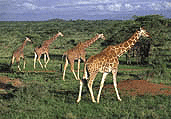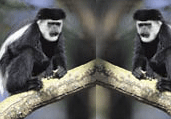|
Meru National Park lies eighty-five kilometers east of Meru
town on the north-eastern lowlands below Nyambene Hills, and about
370 kilometers north-east of Nairobi. Meru National Park is wild
and beautiful, it has diverse scenery from woodlands at 3,400ft(1,036m)
on the slopes of Nyambeni Mountain Range, north east of Mt. Kenya,
to wide open plains with meandering riverbanks dotted with doum
palms. The Tana River bringing life to the land, an especially beautiful
area of Kenya this remote region is a lush green Eden.
Straddling the equator and bisected by 13 rivers and crossed by
numerous permanent streams, draining from the Nyambenes and flowing
in parallel between tounges of lava, south eastwards towards the
Tana River. As well as the many streams that cross it, the park
is bounded by three large rivers: the Tana to the South, the Ura
to the South West and the Rojeweru to the East. There are several
prominent inselbergs of basement rock, notably Mughwango and Leopard
rock. A section of the park has been designated as a wilderness
area. It has diverse scenery from woodlands at 3,000 feet on the
slopes of Nyambeni Mountain Range, northeast of Mount Kenya, to
wide open plains with wandering riverbanks dotted with Doum Palms.
The best time to see game in Meru is early morning and late afternoon.
In the midday heat, most animals retreat to the cool of thick undergrowth
and become invisible. Morning and afternoon game drives also allow
you to witness the unforgettable African dawn and sunsets. There
is a great variety of wildlife at Meru, including Lion, Elephant,
Cheetah, Leopard and some of the rarer Antelopes; lesser Kudu, Duiker
and Dik Dik, one of Africa's smallest antelopes. Large prides of
Lion can be seen and some of Kenya's largest herds of Buffalo. The
rivers abound with Hippo and Crocodile. In the mid 1980's, the Park
suffered from poaching, however Kenya Wildlife Service armed wildlife
security patrols have driven out the poachers and the elephant population
has stabilised with breeding herds settling down. Over 300 species
of birds have been recorded including: the Peter's Fin foot which
inhabits the Murera and Ura Rivers, the Pel's Fishing Owl, Kingfishers,
Rollers, Bee-eaters, Starlings and numerous Weavers.
The Park is popularly known as Elsa Country where the late world
famous Joy Adamson reared the orphaned lioness and later rehabilitated
her in the wild. Joy Adamson's wrote book "Born Free"
-- the story of the Adamson's life and research amongst lion and
cheetah. "Elsa" the lioness was the most well-known her
grave is marked here. .She also raided Pipa the cheetah, made famous
in her book “The Spotted Sphinx” and later released
her into the bush. Wildlife is prolific and varied.
Further along the Tana River from Meru, there is access to the smaller
Kora National Park, and three reserves Bisanadi, North Kitui, and
Rahole.
There are two routes to Meru national park from Nairobi. The first
is the main road via Nyeri, Nanyuki and Meru, the second is via
Embu-Meru road. It offers the best approach via the Ura gate. Dry
weather route from Meru is through Mathara and Kangeta towards Maua
turning left on the Kinna road leading to the National park gate.
There are airstrips and leopard rock or Meru Mulika lodge.
|






